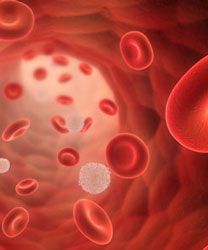Lower Dose ATLG Safer, More Effective in Children With Hematologic Malignancies
A 15 mg/kg dose of rabbit anti-T-lymphocyte globulin was associated with similar graft-vs-host-disease, less nonrelapse mortality, and less disease recurrence compared with a 30 mg/kg dose for children with hematological malignancies.
mcl

A 15 mg/kg dose of rabbit anti-T-lymphocyte globulin (ATLG) was associated with similar graft-vs-host-disease (GVHD), less nonrelapse mortality, and less disease recurrence compared with a 30 mg/kg dose for children with hematological malignancies.
Children who had previously undergone allogeneic hematopoietic stem-cell transplantation (HSCT) from an unrelated donor (N = 180) enrolled in a randomized, open-label, phase III trial conducted at 7 Italian medical centers. From January 2008 through September 2012, 91 patients were assigned to 15 mg/kg of ATLG and 89 were assigned to the 30 mg/kg dose. This analysis included data from 88 patients in the 15 mg/kg-arm and 84 in the 30-mg/kg arm.
“Our data obtained in a randomized clinical trial with a long follow-up indicate that, in children with hematological malignancies transplanted from an unrelated donor selected through high-resolution HLA typing, the use of 15 mg/kg rabbit ATLG results in better overall survival and event-free survival than a 30 mg/kg dose,” the investigators wrote. “15 mg/kg ATLG can spare life-threatening viral infections without significantly increasing the incidence of acute and chronic GVHD, and without adversely affecting other outcomes such as engraftment or relapse.”
The primary endpoint of the study was 100-day cumulative incidence of grade 2 to 4 acute GVHD in the 2 treatment groups. Secondary endpoints included cumulative incidence of chronic GVHD, disease recurrence, and nonrelapse mortality, defined as the probability of death from time of HSCT from any cause other than disease recurrence or progression.
No patient required dose reduction or discontinued the planned treatment for any reason, including drug-related toxicity.
The median follow-up was 3.4 years for the whole study population, 4.2 years for patients alive at last follow-up, and 0.7 years for those who died. For patients who survived, the median follow-up was 4.2 years for the 30-mg/kg group and 4.1 years for the 15-mg/kg group.
The overall 100-day cumulative incidence of grade 2 to 4 acute GVHD for all patients was 33% (95% CI, 26-40), and 7% (95% CI, 4-12) for grade 3/4 acute GVHD. Investigators found that the cumulative incidence of all-grade acute GVHD was similar between the 2 groups. Similarly, there was no difference between the 2 groups for chronic GVHD.
The overall cumulative incidence of nonrelapse mortality was 14% (95% CI, 9-21). Fifteen patients (18%) in the 30-mg/kg group died in remission due to transplant-related causes, compared with 8 (9%) in the 15-mg/kg group. Investigators noted that infection-related deaths were twice as common in the 30-mg/kg arm (7 vs 3).
Patients receiving the 30-mg/kg dose had a greater cumulative incidence of viral reactivations. The difference was significant for Epstein-Barr virus reactivation (37% vs 23%; P = .038) and for adenovirus reactivation (12% vs 1%; P = .02). Two patients assigned to the 30-mg/kg dose developed posttransplantation lymphoproliferative disorders and 1 died from this complication.
Investigators also found that the incidence of human cytomegalovirus reactivation (38% vs 32%; P = .48) and invasive aspergillosis (6% vs 2%; P = .26) was slightly higher in the 30-mg/kg arm, but the difference was not significant.
At a median of 6.6 months posttransplantation, the cumulative incidence of relapse was 15% (95% CI, 12-24). Seventeen patients in the 30-mg/kg group experienced relapse compared with 12 in the 15 mg/kg group.
At the last follow-up, 54 patients in the 30-mg/kg arm were still alive versus 69 in the 15-mg/kg group. Five-year overall survival probability favored the 15-mg/kg arm, 78% versus 62% (hazard ratio [HR], 1.80; 95% CI, 1.01-3.2; P = .045).
Overall 5-year event-free survival (EFS) was 69% (95% CI 62-76). For patients in the 30-mg/kg arm, 5-year EFS 61% compared with 77% for the 15-mg/kg group (HR, 1.87; 95% CI, 1.07-3.28; P = .028).
In the multivariable analysis of EFS, 30 mg/kg dose, HLA disparity of more than 1 allele, and high-risk disease were all associated with poorer outcome. Only the high-risk disease group was significantly associated with an increased risk for relapse, whereas the 30-mg/kg dose was associated with an increased risk for nonrelapse mortality.
Locatelli F, Bernardo ME, Bertaina A, et al. Efficacy of two different doses of rabbit anti-T-lymphocyte globulin to prevent graft-versus-host disease in children with haematological malignancies transplanted from an unrelated donor: a multicentre, randomised, open-label, phase 3 trial. Lancet Oncol. 2017;18(8):1126-1136. doi: 10.1016/S1470-2045(17)30417-5.



